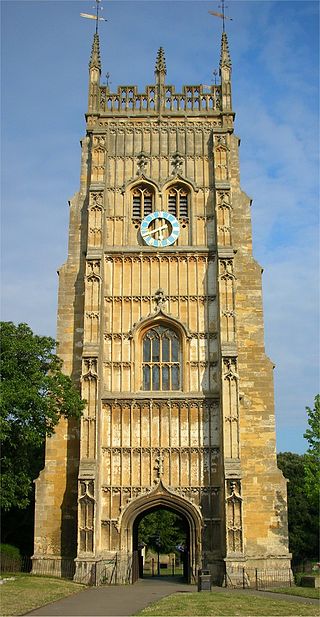
Evesham Abbey was founded by Saint Egwin at Evesham in Worcestershire, England between 700 and 710 following an alleged vision of the Virgin Mary by a swineherd by the name of Eof.

Henry Chichele was Archbishop of Canterbury (1414–1443) and founded All Souls College, Oxford.

East Northamptonshire was a local government district in Northamptonshire, England, from 1974 to 2021. Its council was based in Thrapston and Rushden. Other towns included Oundle, Raunds, Irthlingborough and Higham Ferrers. The town of Rushden was by far the largest settlement in the district. The population of the district at the 2011 Census was 86,765.
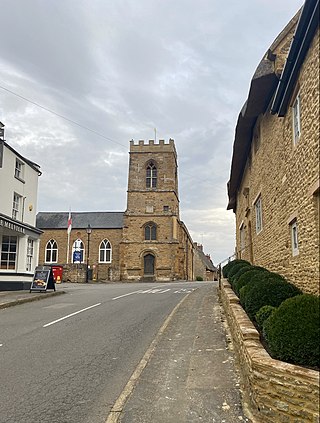
Boughton is a village and civil parish in West Northamptonshire, England. It is situated approximately 4 miles (6 km) from Northampton town centre along the A508 road between Northampton and Market Harborough.

St. Michael's Church is an Anglican parish church in Ashton-under-Lyne, Tameside, Greater Manchester, England. The church is a Grade I Listed Building. The church dates back to at least 1262, and a church on the site was mentioned in the Domesday Book. The church was rebuilt in the fifteenth century; however little of the previous church remains after it was rebuilt again in the nineteenth century and is still an active place of worship.

Stoke sub Hamdon Priory is a complex of buildings and ruins which initially formed a 14th-century college for the chantry chapel of St Nicholas, and later was the site of a farm in Stoke-sub-Hamdon, Somerset, England. The only building remaining from the college is a great hall and attached dwelling, dating from the late 15th century. The hall is designated by English Heritage as a Grade I listed building, while the outbuildings and gateway are Grade II listed. The whole site has been scheduled as an ancient monument. A number of the farm buildings are in poor condition, and have been added to the Heritage at Risk Register.

Ettington is a village and civil parish about 5.5 miles (9 km) south-east of Stratford-upon-Avon in Warwickshire, England. The 2011 Census recorded the parish's population as 1,171. The present village is on the A422 main road linking Stratford and Banbury. The A429 main road linking Warwick and Cirencester used to run through the village, and now uses a bypass just west of it. The Fosse Way Roman road crosses the A422 0.6 miles (1 km) east of the village.
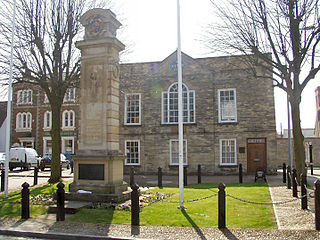
Higham Ferrers is a market town and civil parish in the Nene Valley in North Northamptonshire, England, close to the Cambridgeshire and Bedfordshire borders. It forms a single built-up area with Rushden to the south and had a population of 8,827 at the 2021 census. The town centre contains many historic buildings around the Market Square and College Street.
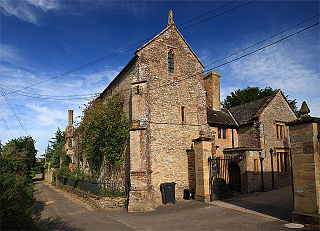
Naish Priory in East Coker, Somerset, England, contains portions of a substantial house dating from the mid 14th century to around 1400. Emery says the building was not a priory as it had been termed by the late 19th-century owner Troyte Chafyn Grove, and there appears no evidence of ownership by a religious house or the residence of a large community of monks on the site. However, there is evidence of a dormitory and communal living dating from the 14th century, and the extant buildings grew on a foundation that had religious obligations by way of chantry to the de Courtenay Earls of Devon from at least 1344. It has been designated as a Grade I listed building, with the attached Priory Cottage and northern boundary railings.
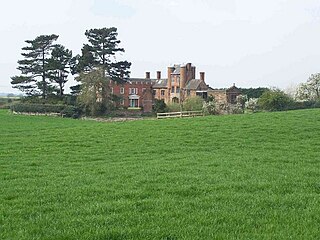
Pillaton Hall was an historic house located in Pillaton, Staffordshire, near Penkridge, England. For more than two centuries it was the seat of the Littleton family, a family of local landowners and politicians. The 15th century gatehouse is the main surviving structure of medieval Pillaton Hall. It is a Scheduled Ancient Monument and a Grade II* listed building. Attached to the Gatehouse to the east is the chapel formerly dedicated to Saint Modwen.
West Mersea Priory was a Benedictine priory in West Mersea, Essex, England. It was founded in 1046 and granted by Edward the Confessor to the Abbey of Saint-Ouen in Rouen. As an alien priory it was taken by Henry V who granted it in 1422 to Henry Chichele, archbishop of Canterbury, for his college at Higham Ferrers. The priory was dissolved in 1542. There are no physical remains.

New Romney Priory, or the Priory of St John the Baptist was a 13th-century monastic grange in New Romney, Kent, England. Remains of the priory survive in the town.
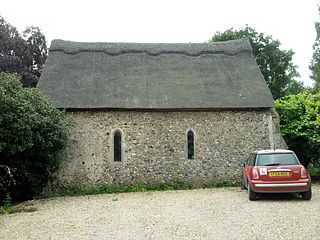
St James' Chapel is a 13th-century chapel located near the village of Lindsey, Suffolk, England. Built in 1250 of flint, brick and stone, the small church served as the chantry chapel for nearby Lindsey castle. The chapel was in use until 1545 when it was dissolved as a "free chapel". After dissolution, the King granted the property to Thomas Turner, who converted the building into a barn. St James' chapel is recorded in the National Heritage List for England as a designated Grade I listed building and scheduled monument.

St Mary's Church, Higham Ferrers is a Church of England parish church in Higham Ferrers, Northamptonshire. It is a Grade I listed building.
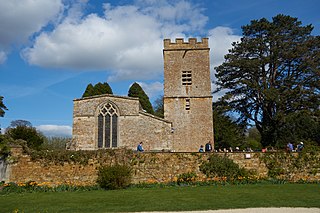
The Church of St Mary the Virgin is the Church of England parish church of Chastleton, Oxfordshire, England. It is a parish church in the parish of Little Compton, along with those of Cornwell, Daylesford and Little Rollright. The parish is part of the Team Benefice of Chipping Norton, along with the parishes of Chipping Norton with Over Norton, Churchill and Kingham. The Benefice of Chipping Norton is part of the Diocese of Oxford.
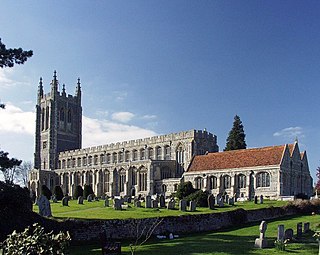
The Church of the Holy Trinity is a Grade I listed parish church of the Church of England in Long Melford, Suffolk, England. It is one of 310 medieval English churches dedicated to the Holy Trinity.

All Saints' Church, Shuart, in the north-west of the Isle of Thanet, Kent, in the south-east of England, was established in the Anglo-Saxon period as a chapel of ease for the parish of St Mary's Church, Reculver, which was centred on the north-eastern corner of mainland Kent, adjacent to the island. The Isle of Thanet was then separated from the mainland by the sea, which formed a strait known as the Wantsum Channel. The last church on the site was demolished by the early 17th century, and there is nothing remaining above ground to show that a church once stood there.

St Mary's Bridge Chapel is a Church of England chapel in Derby, England. It is a bridge chapel, one of only a small number of medieval age that survive in England. It is a Grade I listed building.
There are 221 scheduled monuments in the county of Northamptonshire, England. These protected sites date in some cases from the Neolithic period and include barrows, artillery forts, ruined abbeys, castles, and Iron Age hill forts. In the United Kingdom, the scheduling of monuments was first initiated to ensure the preservation of "nationally important" archaeological sites or historic buildings. Protection is given to scheduled monuments under the Ancient Monuments and Archaeological Areas Act 1979.


















